Ask space shuttle astronauts to call up memories of their time in orbit and they’re not likely to focus on the data they gathered or the payloads they launched. They might talk instead about a meal shared with crewmates in weightlessness, or the beauty of auroras viewed from above, or the sense of community they felt with everyone looking down at Earth from space. That’s a uniquely human perspective. Satellites have no such feelings.
We tend to focus on the machine when we think of the space shuttle—the raw power and the intricate engineering. But the people inside were always the point. The shuttle carried human society into orbit, a few individuals at a time, for 30 years. The astronauts lived and worked in a most unusual environment for short periods, seeing things the rest of us will never see. Until orbital tourism companies start launching people in greater numbers, the shuttle program will remain the high-water mark of human space exploration. And as this sampler of stories (most of which appeared in our 2002 book, Space Shuttle: The First 20 Years) shows, the astronauts who’ve been to orbit have tales to tell.
Pictured above: Dave Williams and Jay Buckey, both first-time space fliers, look out Columbia’s aft flight deck window during the STS-90 mission in 1998.
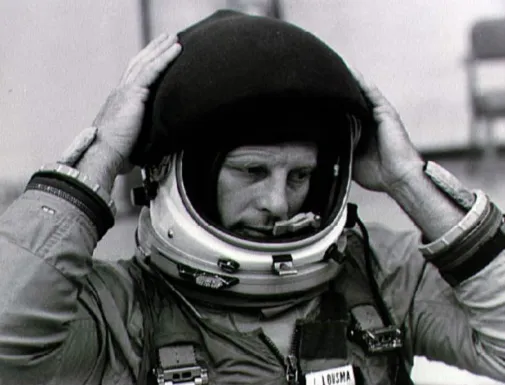
Jack Lousma: We Wanted to Rescue Skylab
In the late 1970s, while the shuttle was still in development, Fred Haise and I were assigned to do a Skylab rescue attempt on the third flight. We had already abandoned the Skylab space station, which had been in orbit since 1973. They’d stopped listening to it, and were just tracking it as an object in space. From the tracking it was clear that the station was coming down sooner than we thought it would, because solar eruptions were periodically heating up and expanding the atmosphere at that altitude, which had a drag effect. So they decided, “Gee whiz, we’ve got to figure out a way to either bring it down in a controlled way or put it higher.” So they contacted the Skylab, and found that, sure enough, they could control it.
On the third shuttle flight we were going to go up and rendezvous with the Skylab, then we were going to pop this booster package out of the shuttle and fly it over and hook it on the space station, where the Apollo command/service module was normally docked. The package had a television camera on the front, so you would get a view as if you were flying the command/service module in for a docking. The picture would be relayed back to the space shuttle, where I would have had a hand controller. I would fly the booster package over to Skylab, dock it, then stand off somewhere and fire the engine either to make the station go higher or make it go in the water.
That was the plan. I worked on that for about a year, knowing that I was going to fly the third flight. This is what I was doing while the STS-1 and -2 crews were training for their missions. Originally we were planning to fly the first shuttle in 1978 or thereabouts, but the STS-1 launch kept slipping. And Skylab was coming down so fast—it finally reentered in 1979—that we realized STS-3 might not launch soon enough. So Fred and I were assigned to STS-2, because there was still a chance of making it. But the first launch kept slipping, to the point where they decided not even STS-1 could get there in time.
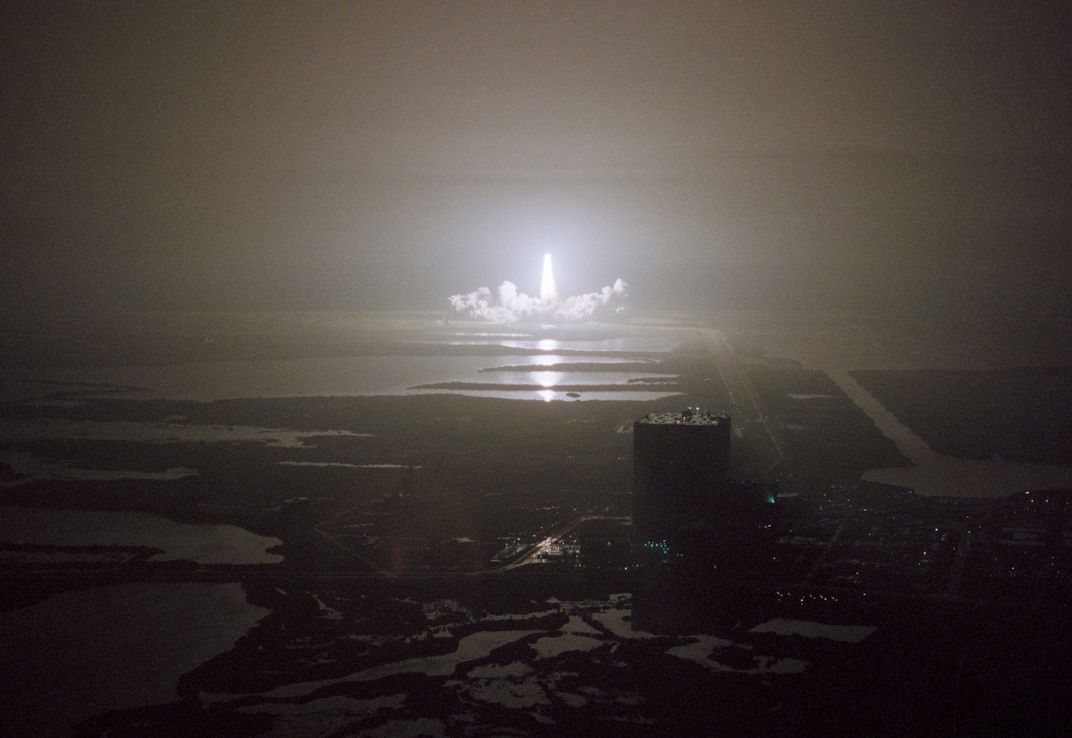
Dan Brandenstein: “How do the engines look?”
During the STS-8 ascent, Dale Gardner couldn’t see a whole lot because he was sitting behind my pilot’s seat and didn’t have the responsibilities of the flight engineer. But we have these overhead windows, like a moon roof on a car, and he could look back over his shoulder and watch the ground disappear. He was commenting, “There are the solid rockets lighting” and “You can see all the way down the coast” and that sort of thing.
After the solids separated, the light level went real low because this was a night launch. A couple of seconds later, Dale said in an excited voice, “Dan, how do the engines look?” As the pilot, I was monitoring the systems, and I said, “Oh, they look fine.” A couple of seconds later, he said again, “Dan, how do the engines look?” I said, “They’re running fine. They look good.”
Then a little while later, “Dan, how do the engines look?”
“They’re fine, they’re fine.” He did that three or four times.
We got into orbit, and that night over dinner I asked Dale, “What in the world was going on?” He had remembered something from long before the first shuttle flight, when they were first testing the engines. They’d start them up and the flame would be very solid and stable coming out of the nozzle. Then, just before the engine blew up, the flame would flutter. And from his perspective, looking out that overhead window, it looked like the flame was fluttering, especially as we got higher in altitude, where the air pressure was lower. Dale is extremely bright, an amazing individual, and he had put those two data bits together. And because of where he was sitting, he was the only one who saw it. He made a point to debrief the crews after us so that other people wouldn’t share his concern.
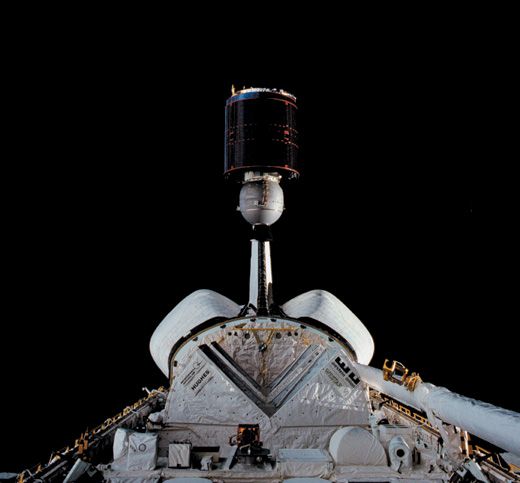
Bob Cenker: This One Was Mine
At the time of our 61-C mission in 1986, the Satcom was the highest-powered communications satellite ever built. It was a three-kilowatt spacecraft, which is tiny now, but at the time was a lot. And this was mine. I had worked on it at RCA for two years—it was the first spacecraft where I had been manager of systems engineering, so I was technically responsible for it.
When we deployed the satellite from the shuttle, I was lying on the ceiling, watching through binoculars, and it was surreal. I just lay there for about 15 or 20 minutes before it went into darkness. I saw the omni antenna go out, and I remember calling back, “We have the omni deployed.” It was this 10,000-pound thing floating free out of the cabin, spinning at around 40 or 50 rpm. To me it all seemed to be in slow motion.
I remember being warned about the sound the satellite makes as it leaves the cargo bay. The first time they did one of these deploys, I’d been told that it scared everybody onboard. Because you mostly have silence in space. I mean, you hear fan noise, but people are attuned to the quiet. And when the satellite is deployed, you’ve got these explosive bolt cutters that release it. The shuttle is an all-metal structure, so the sound just rips through the vehicle. By the time of our flight we had been forewarned, though, so I wasn’t particularly surprised when it happened.
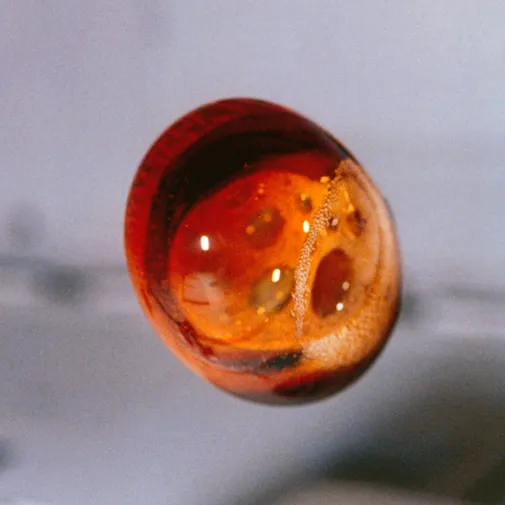
Loren Acton: The Coke and Pepsi Flight
Coca-Cola had gotten permission do an experiment in space to see if they could dispense carbonated beverages in weightlessness. They got approval to build this special can, put significant money into it, and were all set to fly it on one of the early shuttle missions. This was during the “Cola Wars,” when Ronald Reagan was in the White House. And somebody at a high level at Pepsi found out about this, went to their contacts in the White House and said, “This cannot be allowed to happen—that Coca-Cola would be the first cola in space.”
So the Coke can was taken off the mission it was supposed to go on, and Pepsi was given time to develop their own can so they could both fly on the same flight. It turned out that our 51-F mission ended up getting the privilege of carrying the first soda pop in space. Well, we got our cans for training. And indeed, the Coke can had had a lot of work put into it, and was designed to dispense a beverage without stirring up the liquid. The Pepsi can, when it showed up, looked like a shaving cream can. In fact, the Pepsi logo was just stuck on a paper wrapper, and when we peeled it off, indeed it was just a shaving cream can. It still had the shaving cream logo on it. Pepsi understood that this had nothing whatsoever to do with soda in space. It had to do with PR.
During training, the legal beagles at NASA headquarters got into the act. The rule came down that the cans would be covered during testing, so that no logo could be seen. And we would not be photographed during this testing. Then the directive came that the cans would be covered, but now we could be photographed. Then the next ruling was that the cans would be uncovered, the logo had to be visible, we could be photographed with still cameras, but we were not to be photographed with movie cameras. One thing after another came down, and this stupid thing was taking more time than our serious experiments. But we all took it in pretty good humor.
Well, the morning before the launch there is always a briefing, during which all the last minute things that need to be talked about get talked about. We were about halfway through a briefing on the latest data concerning the Sun—our flight had several solar physics experiments—when who should walk in but the Chief Counsel of NASA, who began to brief us once again on the Coke and Pepsi protocols.
At that point—and non-NASA payload specialists like me could get away with things that maybe career astronauts couldn’t—I just blew my stack and said, “We’ve been getting ready for this mission for seven years. It contains a great deal of science. We have a very short time to talk about the final operational things that we need to know. We don’t have time to talk about this stupid carbonated beverage dispenser test. Please leave.” He turned and walked out. But we did do our test in space. The red team did the Pepsi, and the blue team—we were divided into shifts—did the Coke. We took the still photographs, and we showed the logo. And indeed, the Coke can dispensed soda kind of like what we’re used to drinking on Earth. And the Pepsi can dispensed soda filled with bubbles—fun to play with in zero-g, but not very drinkable. Still, when I’m giving talks in schools, they are a lot more interested in Coke and Pepsi than they are in solar physics.
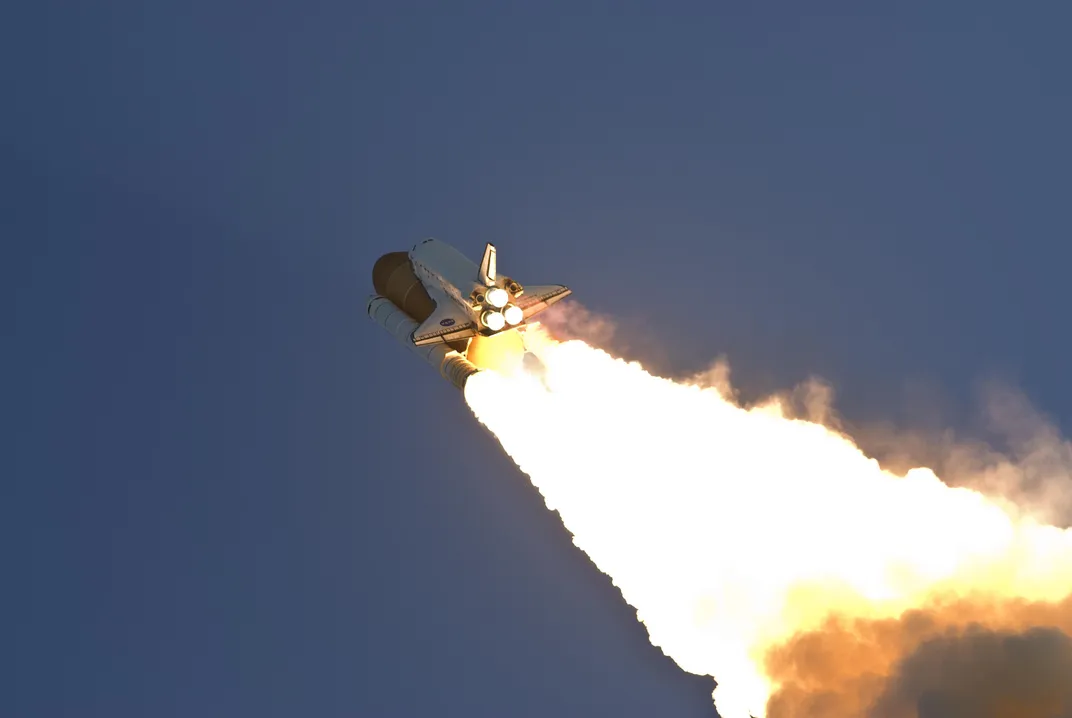
Jim Voss: Because I’m Scared to Death
We were sitting there on the launch pad before the STS-44 launch, and there was a lot of banter in the cockpit, a lot of kidding around and stuff. It was the nervous sort of banter you get on a sports team before it goes out to play. Tom Henricks, the pilot, who like me was about to launch for the first time, noticed that Story Musgrave, who was making his fourth flight, was pretty quiet—he hadn’t been joining in all this kidding. And Tom said, “Story, how come you’re so quiet over there?” And Story, just as serious as can be, said, “Because I’m scared to death.” It got just deathly quiet in the cockpit then. It was really pretty funny. I don’t think another word was said for the last couple of minutes before launch, because everybody starting thinking, “Well, maybe we need to be thinking about this a little more seriously.”
/https://tf-cmsv2-smithsonianmag-media.s3.amazonaws.com/filer/gibson.jpg)
Hoot Gibson: NASA Photo by Hooter
By the time we came to the first tests of the Manned Maneuvering Unit jetpack on 41-B, we felt positively snakebit. We had already on this flight stranded two commercial satellites in worthless orbits after their onboard rockets failed, and a balloon target we were going to use for rendezvous tests had blown up. Now we get to the MMU, and it couldn’t have gone better. Bruce McCandless first did a couple of brief test flights in the cargo bay, staying very close in case anything should go wrong. As we were approaching sunrise on one of our daylight passes, he was cleared to make the translation out to 300 feet from the shuttle. He started floating away, and I picked up the Hasselblad and thought, “I don’t believe the image I am seeing out of this camera.” The horizon was right there, and Bruce appeared at about a 30-degree angle because we in Challenger were 30 degrees from the vertical.
I started shooting, and I got very, very serious about these photos, because I thought to myself, “If I don’t mess this up I’m going to get an Aviation Week magazine cover out of this.” I must have taken three light ratings for every photo that I shot, and tweaked the focus six times for every time I squeezed the button. I shot a whole series of photographs of the MMU, and, sure enough, they made two Aviation Week covers. I’ve been very proud of those photos, because they have become some of the most used NASA photographs of all time. You see them everywhere, including the subscription cards inside Air & Space magazine. They never have my name on them. It never says, “NASA photo by Hooter.” But I know who shot it.
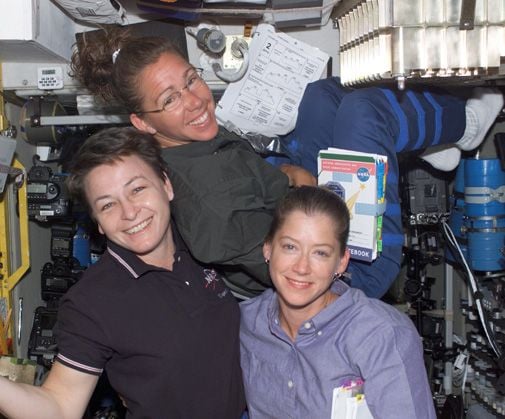
Pam Melroy: Somebody Else's House
When I flew on STS-92, there was no crew living onboard the station yet. We opened the hatch, kind of threw our stuff in, and hung out like it was a hotel room we were visiting. It was our space. We could do whatever we wanted, because nobody lived there. But then on STS-112 and –120, I was visiting somebody else’s house. So all those little subtle details about where you put stuff, it’s a big deal. And there are some real challenges. One thing I was very happy about is that Peggy Whitson and I had flown together before, when I was on STS-112 and she was living on the space station. I got a pretty good sense of who she was and how she liked to do things. So having her as the commander of the station, and me as the commander of the shuttle, was a big plus for both of us. We’d actually flown together, and you just don’t know people until you fly with them.
/https://tf-cmsv2-smithsonianmag-media.s3.amazonaws.com/filer/e6/f4/e6f461fa-ed3a-4934-b9e4-86e3f2f5a4bf/spaceplanes.jpg)